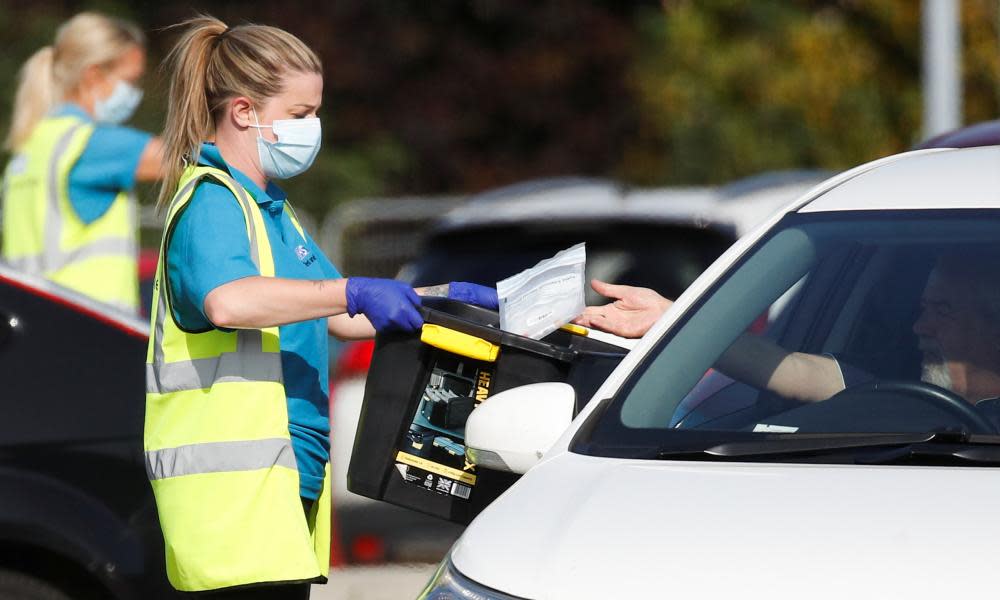England Covid cases almost doubled within a week, according to ONS

Coronavirus cases in England almost doubled in the space of a week, with infections becoming more widespread across all ages, leading one expert to say a second wave had begun.
Almost 60,000 people are thought to have had the virus from 4 to 10 September 2020 – one in every 900 people – with about 6,000 new cases per day, according to the ONS survey of randomly selected people in the community.
The previous week, about 1 in 1,400 people are thought to have had the virus, with 3,200 new cases per day. “The estimates show that the incidence rate for England has increased in recent weeks,” the ONS team writes.
There was evidence of higher infection rates in north-west England and London. The R figure – the average number of people one infected person infects – was also revealed to be 1.2-1.4 in England and 1.1-1.4 UK-wide, up from 1.0-1.2 last week.
Tim Spector, a professor of genetic epidemiology at King’s College London, who leads the Covid symptom study, said the data suggested a second wave of Covid had begun. “The data from the app is painting a worrying picture, with cases on the rise across the UK, with the only exception to that rule being the south-west, where we see numbers staying low,” he said.
Prof Steve Riley from Imperial College London said the ONS findings were consistent with data from the recently released React-1 study, which suggested cases of the virus in England were doubling every seven to eight days. “This is additional evidence supporting the need for reduced social contact to avoid future increases in Covid-19 hospitalisations and deaths,” he said.
The ONS figures also confirm that, in the week that schools returned in England, cases appear to be have risen most among primary-school-age children and adults under the age of 35.
However experts said the data also showed some increase in older adults, with the average percentage of individuals testing positive for Covid-19 rising from 0.04% to 0.12% among 50- to 69-year-olds between 19 August and 10 September – although the ONS cautions there is uncertainty around the true size of this increase.
The figures come the same day that Yvonne Doyle, medical director at Public Health England, stressed the virus was not confined to the young. “We’re seeing clear signs this virus is now spreading widely across all age groups and I am particularly worried by the increase in rates of admission to hospital and intensive care among older people.”
The government has applied tighter restrictions to nearly 2 million people living in north-east England, including a 10pm curfew for venues such as bars and restaurants and a ban on people socialising with those from other households. Similar restrictions are set to be rolled out in the north-west, the Midlands and West Yorkshire from Tuesday.
The ONS has also reported on the situation in Wales, revealing that about 1 in 2,000 people are thought to have had the virus in the week from 4 to 10 September 2020, an increase from 1 in 2,600 people the previous week.
However the ONS team say they detected very few positive tests and the results show no clear sign of a rise. “Our modelling suggests that the number of Covid-19 cases in Wales is currently relatively stable,” they write.
A rise in cases has also been reported by researchers behind the Covid symptom study app, which revealed cases to be highest in the north of England and the Midlands.
While the ONS survey captures symptomatic and asymptomatic cases, the Covid symptom study from Spector focuses on people with symptoms, but covers the whole UK.
Based on 8,124 swab tests, results suggest that over the two weeks up to 13 September there were an average of 7,536 daily new symptomatic cases of Covid in the UK. The team add that the data indicates almost 70,000 people in the UK currently have symptomatic Covid – almost twice the figure of 35,248 from the week before.
Responding to the ONS figures, Dr Kit Yates, a senior lecturer in mathematical biology at the University of Bath, said the situation was concerning. “The time between the reporting periods for the ONS’s latest figures was five days rather than the usual seven. Since these changes occurred over a five-day period we might expect that the doubling time is even faster than a week.”
According to the latest R data, only the south-west has an R number that could be below 1; the Midlands and the north-west have the highest values, with both having an R number thought to be between 1.2 and 1.5.

 Yahoo News
Yahoo News 
